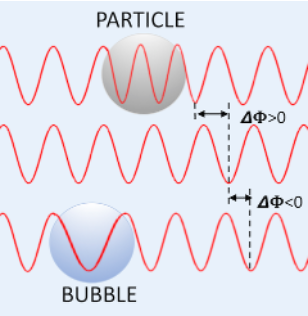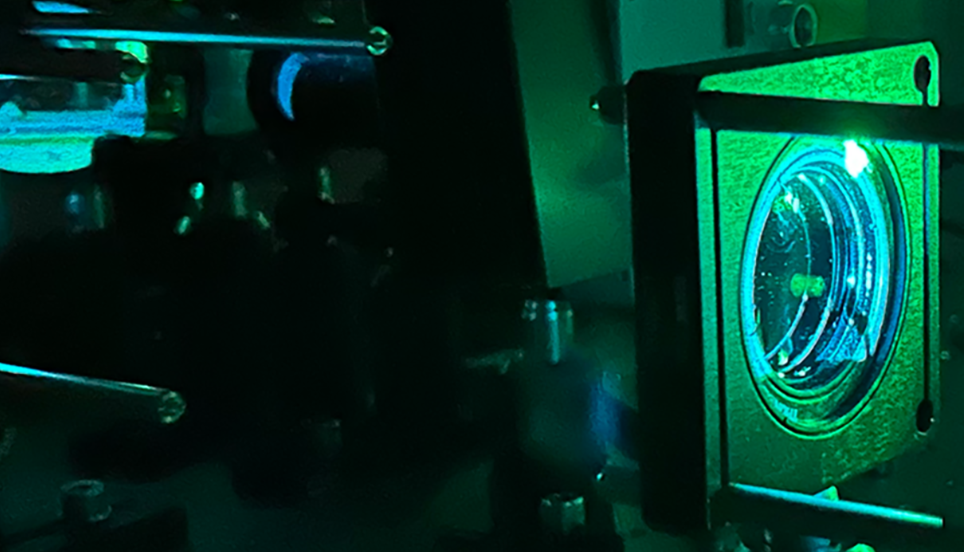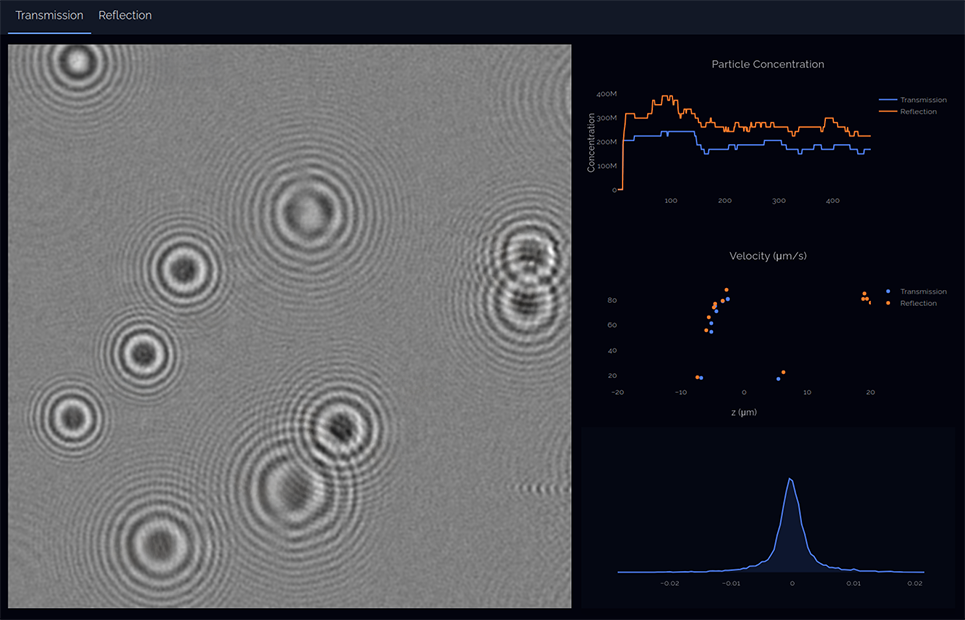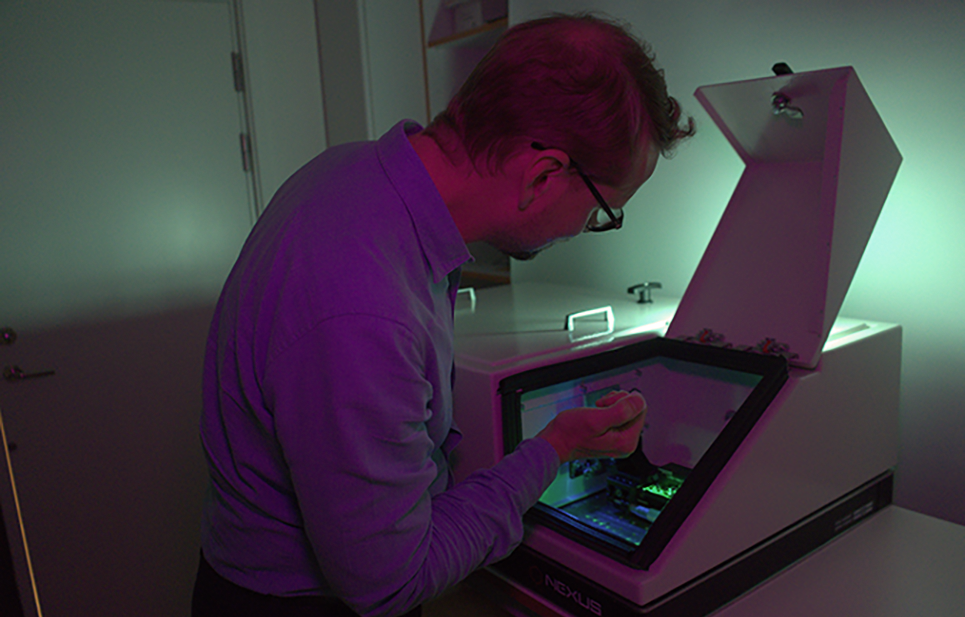Technical Description
Nanoparticle Tracking Analysis and Hydrodynamic size
Colloidal particles in liquid undergo random Brownian motion due to interaction with surrounding water molecules. The movement (diffusion) during a certain time period is dependent on particle volume and the temperature and viscosity of the medium. This relationship is described by the Stokes-Einstein equation.
By detecting a particle’s position in a sequence of images, it’s Brownian motion can be analyzed and the size of the particle be estimated. This is what is commonly referred to as Nanoparticle Tracking Analysis (NTA). The larger the number of positions detected, the better the estimation.
DAISY tracks particles moving through a microfluidic channel at a speed of at least 800 frames per second. The flow rate of particles through the channel is tightly controlled ensuring a high number of data points for each particle.
Refractive Index and Phase Shift

The refractive index (RI) of a material is the ratio between the speed of light in vacuum and the speed of light in the material. When light passes through a small transparent particle it is ”delayed” compared to lightpassing through the medium alone. This delay is the phase shift.
If passing through an air bubble in water, the light instead moves faster than through the surrounding medium and achieves a phase shift of opposite sign. The phase shift is proportional to the volume of the particle and the difference in RI between the particle and the surrounding medium.
DAISY uses this phase shift, measured directly through digital holographic microscopy, in combination with the hydrodynamic size, to derive the refractive index of individual particles.
Digital Holography
DAISY applies the unique capabilities of digital holographic microscopy to nanoparticle tracking analysis. Digital holographic microscopy is a form of quantitative phase imaging, this means that it is possible to separate and independently quantify both phase and intensity data from recorded images (holograms). Furthermore, these holograms can be reconstructed into true three dimensional representations of the imaging field. This means that DAISY produces accurate three dimensional recordings of the entire imaging channel depth at a rate of at least 800 frames per second. Deconvolution of recorded holograms allows perfect re-focussing of particles and quantitation of their phase shift from every frame of recording. Due to the high frame rate of recording, each particle has many hundred such datapoints during its transit through the field of view. The highly accurate phase shift derived from hundreds of individual frames is combined with the hydrodynamic diameter to assign a refractive index to each particle.
Back-Scattered Light
For back-scattered light, the scattering amplitude is related to both the phase and the intensity of the light scattered by the particle. Similarly to the phase shift observed in digital holography, the backscattering amplitude depends primarily on the particle’s volume and refractive index. However, unlike the intensity and phase of forward scattered light, back-scattered light does not scale monotonously with particle size. This complicates direct derivation of refractive index from quantitation of back-scattered light alone.
The DAISY instrument applies Interferometric scattering microscopy (iSCAT) to analyze back-scattered light. iSCAT takes advantage of the fact that a small portion of light is also reflected by the “floor” and “ceiling” of the microfluidic channel. The interference of this reflected light with the light back-scattered by the particles greatly increases the optical contrast of nanoparticles and dramatically improves the lower detection limit compared to imaging forward scattered light alone.
By combining detection and tracking of particles by iSCAT and correlative image averaging across many hundreds of frames of holographic images, DAISY is able to produce robust phase shift, and hence refractive index, measurements for particles that are below the reliable detection limit of holography alone.
Optical Particle Size
A small particle will scatter light in all directions, but how much light is scattered forward and backward respectively depends on the particle’s size. The smaller the particle is, the more equal is the amount of light scattered forward and backward. Larger particles instead scatter incoming light more forward than backward.
Since the DAISY instrument analyses light scattered both forward and backwards, it is possible to use the ratio of two corresponding measurables to determine the size of a particle optically. This is easiest to realize in the range up to the first minima in backscattered light at a particle diameter of about 250nm.

Form Factor and Particle Geometry
For spherical and homogeneous particles, the optical size and hydrodynamic size is the same. But if the particles are not homogeneous, the optical size will deviate from the hydrodynamic size. For particles where most of the mass is at the periphery, the optical size will be relatively larger than the hydrodynamic size. A typical example is liposomes and extracellular vesicles. If instead most of the mass is at the center of the particle whereas the density is very low at the periphery, the optical size will be relatively smaller than the hydrodynamic size. One typical example of this is aggregates of many smaller particles. The optical size is a similar concept as radius of gyration, but not strictly the same. We therefore choose to call it DAISY size.



